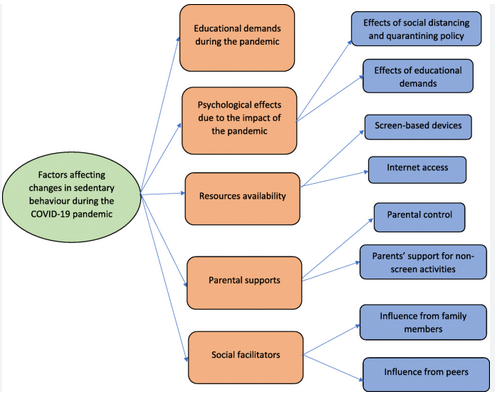Prevalence of Behaviour Changes and Sedentary Lifestyle Among Children and Adolescents During COVID-19 Pandemic in Ghaziabad District of Uttar Pradesh.
Main Article Content
Abstract
Background-The pandemic of the coronavirus has resulted in nationwide school closures, lockdown, and social distancing, resulting in sedentary lifestyle of children and adolescents for substantial amount of time. Objectives: To find the prevalence of lifestyle and behaviour changes among children and adolescents during Covid-19 pandemic. Methodology- Observational cross-sectional study conducted among the children (less than 18 years) in urban population of Ghaziabad city through a house-to-house survey, using a pre-designed, semi-structured questionnaire with a sample size of 666 study participants. Statistical analysis- using Logistic regression and odds ratio. Result - In this study 391 (58.7%) individuals were males and 275 (41.3%) females. Most of the study subject 275 (41.3%) belonged to the five-to-ten-year age group. Among the study participants in one-to-ten-year age group odds of not doing physical activity were twice (OR 1.93 [95% CI 1.129 – 3.290]) as much as those in adolescent (ten to eighteen years) age group. Odds of spending less than two hours in front of screen over and above online classes was more than twice 2.421 [95% CI 1.764-3.323]) among children of parents who had lost their jobs during the pandemic. Conclusion: This study identifies causes responsible for an altered lifestyle among children and their parents during the pandemic and determines an approach to prevent and/or reduce the harmful effects of these changes.
Article Details
References
World Health Organization. [Internet]. Coronavirus disease (COVID-19) pandemic: WHO characterizes COVID-19 as a pandemic. 2020 11 [updated on 2020 July; cited 2021Apr]. Available from: https://www.who.int/emergencies/diseases/novel-coronavirus-2019/events-as-they-happen
Lissak G. Adverse physiological and psychological effects of screen time on children and adolescents: Literature review and case study. Environ Res. 2018; 164:149-57.
Moore SA, Faulkner G, Rhodes RE, Brussoni M, Chulak-Bozzer T, Ferguson LJ et al. Tremblay MS. Impact of the COVID-19 virus outbreak on movement and play behaviours of Canadian children and youth: a national survey. International Journal of Behavioral Nutrition and Physical Activity. 2020; 17:1-1.
Gupta, P., Shah, D., Bedi, N., Galagali, P., Dalwai, S., Agrawal et al. IAP Guideline Committee on Digital Wellness and Screen Time in Infants, Children, And Adolescents (2021). Indian pediatrics. 2021; 1:1-1.
Kirby J, Levin KA, Inchley J. Parental and peer influences on physical activity among Scottish adolescents: a longitudinal study. Journal of physical activity & health. 2011; 1:8.
Allin L, West A, Curry S. Mother and child constructions of risk in outdoor play. Leisure Studies. 2014; 6:644-57.
Gupta P, Parekh B. Screen Time Guidelines for Parents. In: Galagali PM, editor. Guidelines For Parents, 1st ed. New Delhi: Indian Academy of Paediatrics; 2021. p. 3-12.
Carroll N, Sadowski A, Laila A, Hruska V, Nixon M, Ma DW, Haines J. The impact of COVID-19 on health behaviour, stress, financial and food security among middle to high income Canadian families with young children. Nutrients. 2020; 8:2352.
Lin YM, Kuo SY, Chang YK, Lin PC, Lin YK, Lee PH et al. Chen SR. Effects of parental education on screen time, sleep disturbances, and psychosocial adaptation among Asian pre-schoolers: a randomized controlled study. Journal of Paediatric Nursing. 2021; 56:27-34.
Gilbert AS, Schmidt L, Beck A, Kepper MM, Mazzucca S, Eyler A. Associations of physical activity and sedentary behaviours with child mental well-being during the COVID-19 pandemic. BMC public health. 2021; 1:1-2.
Saurabh K, Ranjan S. Compliance and psychological impact of quarantine in children and adolescents due to Covid-19 pandemic. The Indian Journal of Pediatrics. 2020; 7:532-6.

